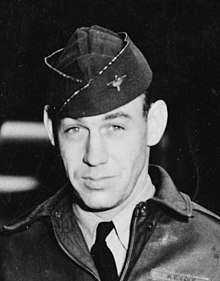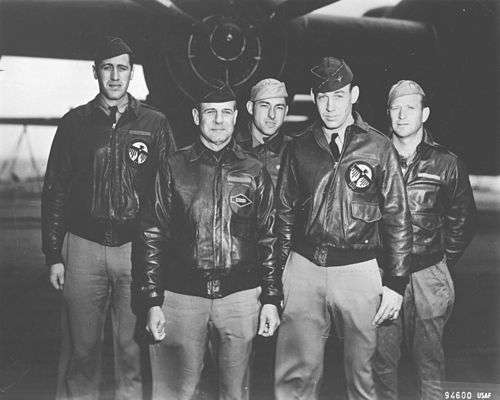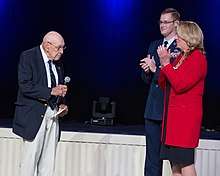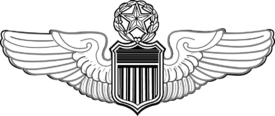Richard E. Cole
| Richard Eugene Cole | |
|---|---|
 1st Lt. Richard E. Cole, | |
| Nickname(s) | Dick |
| Born |
September 7, 1915 Dayton, Ohio, U.S. |
| Allegiance |
|
| Service/ |
|
| Years of service | 1940–1966 |
| Rank |
|
| Unit |
17th Bomb Group 1st Air Commando Group |
| Commands held | 831st Combat Support Group |
| Battles/wars |
World War II • Doolittle Raid • China Burma India Theater Korean War |
| Awards |
Distinguished Flying Cross (3) Bronze Star Medal Air Medal (2) |
Richard Eugene Cole (born September 7, 1915) was a career officer in the United States Air Force. He is one of the airmen who took part in the Doolittle Raid and served as the co-pilot with Jimmy Doolittle in the lead plane of the raid.
Cole remained in China after the raid until June 1943, and served again in the China Burma India Theater from October, 1943 until June, 1944. He later served as Operations Advisor to the Venezuelan Air Force from 1959 to 1962. He retired in from Air Force in 1966.
As of 2018, he is the last remaining member of Doolittle's Raiders.[1][2]
Early life
Cole was born on September 7, 1915 in Dayton, Ohio. As a young kid, Cole used to ride his bicycle from where he lived three or four miles to McCook Field, where he got to watch all the old-timers. He graduated from Steele High School in Dayton, Ohio in the middle of the Great Depression. Cole had made up his mind on going to be a pilot or a forest ranger. He completed two years college at Ohio University.[3]
Military Career
Cole enlisted in the Aviation Cadet Program of the U.S. Army Air Corps on November 22, 1940, and was commissioned a 2nd Lieutenant and awarded his pilot wings at Randolph Field on July 12, 1941. His first assignment was as a B-25 Mitchell pilot with the 34th Bomb Squadron of the 17th Bomb Group at Pendleton, Oregon, from July 1941.
When Cole arrived at Pendleton, the group made a move to Spokane, Washington. They spent the summer there, then got orders to move to Columbia, South Carolina. They trained with the Army Air Corps plus with ground forces. On Dec. 6, 1941, they were at March Field on their way back to Pendleton. The next morning on Dec. 7, 1941, the Japanese attacked Pearl Harbor. Back at Pendleton, th 17th BG changed their bomb racks to accommodate submarine bombing.
Cole and the group were on submarine patrol along the coasts of Oregon and Washington until February 1942. Then they got orders to return to Columbia. They were at a newer airbase, it wasn’t quite finished, mostly mud and water. They lived in tents. Each squadron had an information board that they were required to examine daily.[4]
In February 1942, Cole volunteered for a "secret mission," even though he did not know what duties were involved or any other details. This mission ended up being the critical Doolittle Raid.[4]
Doolittle Raid

Jimmy Doolittle was to plan the attack on Japan and fly the lead B-25 Mitchell during the raid. Cole became his co-pilot and for Crew#1. The normal takeoff with the B-25 loaded in an airfield was somewhere around 3,000 feet. They had to be airborne in 500 feet from an aircraft carrier.[5]
Cole and the other 79 members for the raid set sail on the USS Hornet (CV-8) from San Francisco on April 2, 1942 with 16 B-25 Mitchell bombers each, with a crew of 5 for each B-25.
The plan was to take off 450 miles from the Japanese cost, drop the bombs and land at airfields in China that were controlled by friendly forces. When the Hornet was detected by a Japanese picket ship, Doolittle decided to launch the bombers 200 miles from the planned start point.[6]
The chances of reaching the airfields in western China were slim. They flew 200 feet above the ocean to avoid radar detection. After bombing Tokyo, they did make it to China, but were short of their destination and had to bail out. The weather was bad with moderate to heavy rain. Cole's parachute got caught in a pine tree and as it was a pitch black night and he decided to stay in the tree until daybreak. He spent the night about 12 feet off the ground in the rain and wind. Cole later made it to the village of Chuchow, from where Chinese civilians helped him and the other raiders.[6]
Cole was awarded the Distinguished Flying Cross for the raid and the Chinese Army, Navy, Air Corps Medal, Class A, 1st Grade from Madame Chiang Kai shek.
Post mission
After the raid, Cole remained in the China Burma India Theater flying combat and transport missions, especially over The Hump from May 1942 to June 1943. Cole flew more bombing missions before volunteering for the famed Hump route, ferrying much-needed supplies over the Himalayas into China. Using inadequate aircraft, flying in the world’s worst weather over the highest mountains on the planet, with few navigation aids and inaccurate maps, Cole and other American pilots provided the materiel to keep China in the war against Japan. He returned to U.S. and served with the 5th Fighter Group in Tulsa, Oklahoma, from June to October 1943.
Cole returned to China Burma India Theater and served with the 1st Air Commando Group from October 1943, an elite, highly-secret unit charged with the first-ever aerial invasion of a country. Cole and his crew towed cargo gliders filled with British troops called Chindits into remote jungle clearings in Burma, 150 miles behind enemy lines. The fields were unlit, they flew over Japanese-held territory, braved enemy fire, and did it all at night. The Air Commandos were equipped with fighter aircraft, medium bombers, cargo aircraft, gliders, and the world’s first helicopter.[7]
Cole returned to the U.S. in June 1944. His next assignment was as an Army Air Forces Plant Representative and Acceptance Test Pilot at Wichita, Kansas, from June 1944 to October 1945, and then as Officer in Charge of the Training Section at Victorville Army Air Field, from October 1945 to November 1946. Cole went on terminal leave beginning November 13, 1946, and left active duty on January 11, 1947.[7]
Post war
Cole returned to active duty on July 7, 1947, and served on the group staff at Wright-Patterson Air Force Base, from July 1947 to January 1952. Cole attended Armed Forces Staff College, from January to September 1952.
Korean War
During the Korean War, Cole served on the staff of Far Eastern Air Forces in Japan from September 1952 to March 1955.
Post war
Cole served on the staff of Headquarters U.S. Air Force in the Pentagon from March 1955 to July 1958. After attending Spanish Language Training, he served as an advisor to the Venezuelan Air Force in Caracas, Venezuela, from January 1959 to August 1962, followed by service with the 464th Troop Carrier Wing at Pope Air Force Base, from August to October 1962.
His next assignment was on the staff of the Joint Development Group at Fort Bragg, North Carolina, from October 1962 to February 1963, and then as Director of Operations, Executive Officer, and as Vice Commander of the 831st Combat Support Group at George Air Force Base, from February 1963 until his retirement from the Air Force on December 31, 1966.[8]
Cole was the only American serviceman out of 16 million who served in World War II to have been a Doolittle Raider, Hump pilot, and an Air Commando.
Later life

Cole went into the construction business in Comfort, Texas until his final retirement. He has remained active, traveling around the country to raise money for scholarships that are sponsored by the Doolittle Raiders. In 2014, Cole and the other Doolittle Raiders were awarded the Congressional Gold Medal.[2]
On September 2016, Cole was present at the naming ceremony at the Air Force Association conference, where the Northrop Grumman B-21 was officially named "Raider" in honor of the Doolittle Raiders.[9]
On Fourth of July 2017, President Donald Trump personally spoke with Cole to thank him for his service.[10]
Personal life
Cole is married and has a daughter and two sons. He currently resides in Comfort, Texas. With the death of S/Sgt. David J. Thatcher (Engineer-Gunner of Crew#7) on June 23, 2016, Cole became the last living Doolittle Raider.[11][12]
Awards and Decorations
Cole's awards and decorations include:
 | |||
| Command Pilot | |||||||||||
| Distinguished Flying Cross with two bronze oak leaf clusters | |||||||||||
| Bronze Star | Air Medal with bronze oak leaf cluster |
Air Force Commendation Medal | |||||||||
| Air Force Presidential Unit Citation | Air Force Outstanding Unit Award | American Defense Service Medal | |||||||||
| American Campaign Medal | Asiatic-Pacific Campaign Medal with four bronze campaign stars |
World War II Victory Medal | |||||||||
| National Defense Service Medal with bronze service star |
Korean Service Medal | Air Force Longevity Service Award with silver oak leaf cluster | |||||||||
| Medal of the Armed Forces, A-1 (Republic of China) |
United Nations Korea Medal | War Memorial Medal (Republic of China) | |||||||||
See also
References
- ↑ "Cole". www.doolittleraider.com. Retrieved 2018-09-06.
- 1 2 "Last surviving Doolittle Raider turns 102". 8 September 2017.
- ↑ "Col. Richard Cole, Doolittle's Co-Pilot On Tokyo Raid, Main Draw At Chino Air Show - SBCSentinel". sbcsentinel.com.
- 1 2 news@rockdalecitizen.com, By Pete Mecca. "A VETERAN'S STORY: Interview with The Last Raider".
- ↑ "Dick Cole — Last of the Doolittle Raiders - HistoryNet". www.historynet.com.
- 1 2 "solo mission".
- 1 2 "Col. Richard E. Cole, Doolittle Raider". 8 June 2017.
- ↑ "Col. Richard Cole, Doolittle's Co-Pilot On Tokyo Raid, Main Draw At Chino Air Show - SBCSentinel". sbcsentinel.com.
- ↑ "It's the Raider: Air Force unveils name of new B-21 bomber". AirForce Times.
- ↑ "Donald Trump speaks with Ret. Lt. Col. Dick Cole, last surviving member of 'Doolittle Raiders'". The Washington Times.
- ↑ "David Thatcher, Part of '42 Doolittle Raid on Japan, Dies at 94".
- ↑ CNN, Thom Patterson,. "Last Doolittle survivor recalls US revenge attack".